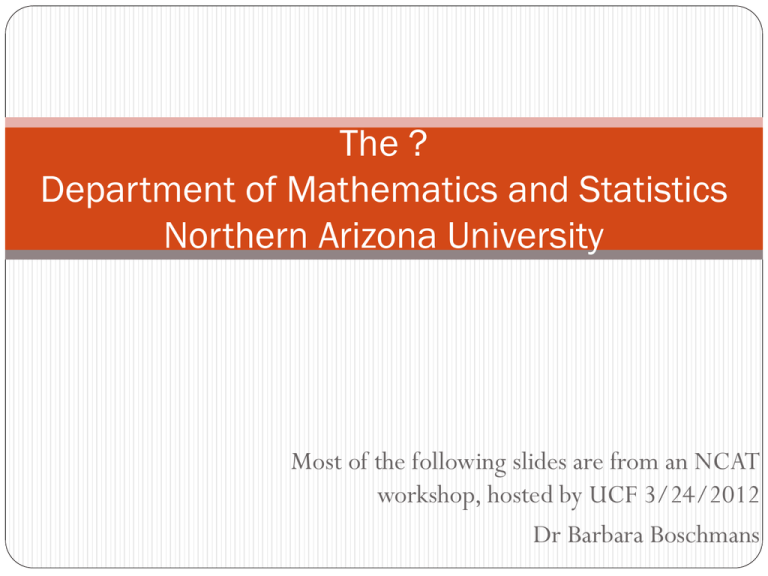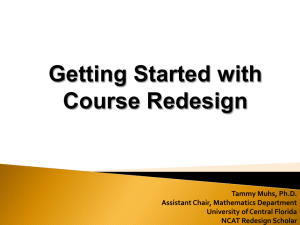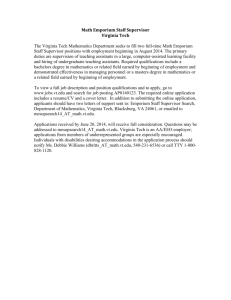The ? Department of Mathematics and Statistics Northern Arizona
advertisement

The ? Department of Mathematics and Statistics Northern Arizona University Most of the following slides are from an NCAT workshop, hosted by UCF 3/24/2012 Dr Barbara Boschmans TRADITIONAL INSTRUCTION Seminars Lectures WHAT’S WRONG WITH THE LECTURE? Treats all students as if they are the same Ineffective in engaging students Inadequate individual assistance Poor attendance and success rates Students fail to retain learning WHAT’S WRONG WITH MULTIPLE SECTIONS? In theory: greater interaction In practice: large class size In practice: dominated by the same presentation techniques Lack of coordination Inconsistent outcomes WHAT DOES NCAT MEAN BY COURSE REDESIGN? Course redesign is the process of redesigning whole courses (rather than individual classes or sections) to achieve better learning outcomes at a lower cost by taking advantage of the capabilities of information technology. WHY REDESIGN? Look for courses where redesign will have a high impact – let’s make a difference: High withdrawal/failure rates Students on waiting lists Students turned away – graduation bottleneck Over enrollment of courses leading to multiple majors Inconsistency of preparation Difficulty getting qualified adjuncts Difficulty in subsequent courses TEAM EFFORT IS KEY Each team included Administrator Faculty experts Technology expertise Assessment assistance 120 REDESIGNED COURSES 160,000 students nationwide Improved student learning: 72% Equivalent student learning: 28% Cost reduction: 37% (9% to 77%) Annual savings: ~$9.5 million Other outcomes Increased course-completion rates Improved retention Better student attitudes toward the subject Increased student satisfaction with the mode of instruction WHY DO STUDENTS FAIL MATH? “The primary reason many students do not succeed in traditional math courses is that they do not actually do the problems. They generally do not spend enough time with the material, and this is why they fail at a very high rate.” REDESIGN CHARACTERISTICS Redesign the whole course—not just a single class Emphasize active learning—greater student engagement with the material and with one another Rely heavily on readily available interactive software— used independently and in teams Mastery learning—not self-paced Increase on-demand, individualized assistance Automate only those course components that can benefit from automation—e.g., homework, quizzes, exams Replace single mode instruction with differentiated personnel strategies Technology enables good pedagogy with large #s of students. THE MATH EMPORIUM: ACADEMIC GOALS Enhance quality by individualizing instruction Assess students’ knowledge in much smaller subject-matter chunks Provide feedback and direction to allow students to make up for specific deficiencies Provide help 75 - 80 hours per week Incorporate examples and information from other disciplines Make changes in the course as it proceeds; continuous improvement as a built-in feature THE MATH EMPORIUM: CHARACTERISTICS Move classes to a lab setting Permit the use of multiple kinds of personnel Allow students to work as long as they need to master the content Can be adapted for the kinds of students at a particular institution Allow multiple courses the same time Include multiple examples in math WHY DOES THE EMPORIUM INCREASE SUCCESS? Active learning: Students spend the bulk of their course time doing math problems. On-demand help: Students get assistance when they encounter problems in doing math. Modularization: Students spend more time on things they don’t understand and less time on things they have already mastered. WHY MODULARIZATION? “Currently, all students spend the same amount of class time working on course elements. The traditional model does not allow for variances in skills areas or learning differences. Modularization will target skills areas for each student, thus speeding up student learning. The learning environment should give more time to deficient skills and less time to those skills at which they are already competent.” "Students learn math by doing math, not by listening to someone talk about doing math." WHAT HAVE WE LEARNED? The Emporium Model works and the Linked Workshop Model works. Modularization works. It’s possible to improve quality while radically reducing costs in developmental and college-level math. Math students at all levels will flourish by using technology appropriately. ASSIGNMENT What are the obstacles to starting a redesign of developmental or college-level math at your campus? What issues do you need to consider? What evidence would help you overcome the obstacles? What information do you need to gather? What process, if any, might help overcome the obstacles? Choose one person to make note of any specific questions. NAU Courses Phase 1 MAT 100 Course Coordinator: Shanna Manny. Fall 2012 will have 800-900 students. It is a 2-credit hour course and students will spend 2 scheduled hours in the ? and one extra hour (required) in the ?. Who will guide these students? TAs? What text will be used? Trigsted? Will there be assessments before the exam? Other questions? NAU Courses Phase 1 MAT 108 Course Coordinator: Katie Louchart. Fall 2012 will have 350 students. It is a 3-credit hour course and students will spend 1 hour in class (in HLC), 2 scheduled hours (required) in the ?, and one extra hour (required) in the ?. What text will be used? Trigsted? Should we have a TA/undergrad tutor in class and then have them be in the lab? Should there be mastery of homework before taking quizzes, mastery of quizzes before taking tests? Benchmark questions on MAT 108 final this spring. UCF Face to Face Class Hour: Students spend one hour in class Review concepts from the previous week Highlight upcoming material Receive administrative information Classroom Response System (iClicker) is used to keep students engaged When a holiday prevents the class from meeting, we use media exercises for the class activity grade UCF MALL Hours: Students spend a required three hours in the Mathematics Assistance and Learning Lab (MALL) • Weekly online hw and quiz assignments • Students get unlimited attempts on hw due night before class • Students get 7 attempts on associated quiz due day of class • MALL staff provide on-demand assistance • Students are in a proctored environment UCF Online Testing: Test Scheduling System (Testing Cal) Scheduling open for a week and students have multiple time options available Testing is completed in a proctored environment using a password system Immediate feedback Free response questions or multiple choice Challenge week ADA time accommodation adjustments Integrity violations almost non-existent Cost savings UCF MALL Staffing: Faculty Students Complete all assignments, become test proctors during testing weeks, and complete training about 14 hours a semester College Reading & Learning AssociationInternational Tutor Program Certification Peer tutors ($8.50-$9.00 per hour) Undergraduate and graduate mathematics students ($8.50- $10.00 per hour) Graduate Teaching Assistants UCF Mentors and Progress Monitoring: Top GTAs are called Mentors Meet with teaching team weekly Communicate with students Hold seminars and test reviews Help with classroom management Progress Monitoring Students Progress is monitored weekly Students receive weekly feedback via email Communication has been shown to have an important role in learning and understanding mathematics (Knuth & Peressini, 2001) NAU Courses Phase 1 MAT 114 Course Coordinator: Matt Fahy. Fall 2012 will have 900 students. It is a 3-credit hour hybrid course and students will spend 1 hour in class (in AMB), 2 (or 3?) scheduled hours (required) in the ?. Big change: instructors will teach one day then be in the lab the other day. Testing will be done in AMB. Can the quizzes be put online? Other questions? NAU Courses Phase 2 MAT 125 Course Coordinator: Amy Rushall. Fall 2013 or 2014? We need a new space before adding more courses! Other questions? Other People Involved TA Coordinator: Matt Fahy Placement Coordinator: Katie Louchart Peak Performance: Amy Rushall/Katie Louchart FYLI Liaison: Amy Rushall Assessment Coordinator: Brian Beaudrie IT Lab Manager: to be hired Tutor/Undergraduate Tutor Supervisor: to be hired … Fall 2012 Open Lab Hours M-Th 2:00-9:00 F 2:00-5:00 Su 5:00-9:00 Can be adjusted if needed! Emporium names at other places Central Florida - The MALL (Mathematics Assistance and Learning Lab) Idaho - Polya Math Learning Center Alabama - Math Technology Learning Center Weber State - The Hub LSU - The Math Lab Jackson State – SMART (Survive, Master, Achieve, Review, Transfer) We need a name (right now)! Mathematics Achievement Center, a.k.a. the MAC LCM: Learning Center for Mathematics ACM: Achievement Center for Mathematics Mathematics Emporium (Classroom) ME or MEC T-SMiLE: Technology-Supported Mathematics (not sure what the i can stand for?) Learning Emporium Center for Mathematics Learning and Activity Mathematics Active Learning Center Center for Actively Learning Mathematics (CALM) Center for Actively Learning Mathematics-Using Technology (CALM-UT) Center for Actively Learning Mathematics-Integrating Technology (CALM-IT) The Summit OR Trailhead EMPIRE: The mathematics emporium integrating technology redefining education MathSpace CAMP : Center for Accelerating Math Performance or Computer Aided Math Proficiency Math Activity Galleria (MAG) Lumberjack Math Center (LMC) Just-in-Time Math Center (JIT-MC) WORDS Mathematics Emporium Learning Space Center Galleria Lumberjack Achieve(ment) Just-in-Time Engage Educational Technology Active/Activities/Actively Contact Information: Carolyn Jarmon cjarmon@theNCAT.org Barbara Boschmans Barbara.Boschmans@nau.edu Tammy Muhs Tammy.Muhs@ucf.edu




